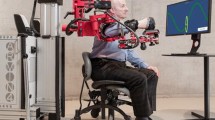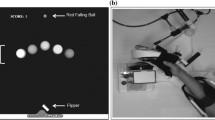Abstract
Performance errors drive motor learning for many tasks. Some researchers have suggested that reducing performance errors with haptic guidance can benefit learning by demonstrating correct movements, while others have suggested that artificially increasing errors will force faster and more complete learning. This study compared the effect of these two techniques—haptic guidance and error amplification—as healthy subjects learned to play a computerized pinball-like game. The game required learning to press a button using wrist movement at the correct time to make a flipper hit a falling ball to a randomly positioned target. Errors were decreased or increased using a robotic device that retarded or accelerated wrist movement, based on sensed movement initiation timing errors. After training with either error amplification or haptic guidance, subjects significantly reduced their timing errors and generalized learning to untrained targets. However, for a subset of more skilled subjects, training with amplified errors produced significantly greater learning than training with the reduced errors associated with haptic guidance, while for a subset of less skilled subjects, training with haptic guidance seemed to benefit learning more. These results suggest that both techniques help enhanced performance of a timing task, but learning is optimized if training subjects with the appropriate technique based on their baseline skill level.







Similar content being viewed by others
References
Binkofski F, Buccino G (2006) The role of ventral premotor cortex in action execution and action understanding. J Physiol Paris 99:396–405
Bluteau J, Coquillart S, Payan Y, Gentaz E (2008) Haptic guidance improves the visuo-manual tracking of trajectories. PLoS ONE 3:e1775
Buccino G, Vogt S, Ritzl A, Fink GR, Zilles K, Freund HJ, Rizzolatti G (2004) Neural circuits underlying imitation learning of hand actions: an event-related fMRI study. Neuron 42:323–334
Buccino G, Solodkin A, Small SL (2006) Functions of the mirror neuron system: implications for neurorehabilitation. Cogn Behav Neurol 19:55–63
Cesqui B, Mazzoleni A, Carrozza M (2008) On the use of divergent force fields in robot-mediated neurorehabilitation. In: IEEE International conference on biomedical robotics and biomechatronics
Dancause N, Ptito A, Levin MF (2002) Error correction strategies for motor behavior after unilateral brain damage: short-term motor learning processes. Neuropsychologia 40:1313–1323
Desmurget M, Grafton S (2000) Forward modeling allows feedback control for fast reaching movements. Trends Cogn Sci 4:423–431
Emken JL, Reinkensmeyer DJ (2005) Robot-enhanced motor learning: accelerating internal model formation during locomotion by transient dynamic amplification. IEEE Trans Neural Syst Rehabil Eng 13:33–39
Emken JL, Benitez R, Sideris A, Bobrow JE, Reinkensmeyer DJ (2007) Motor adaptation as a greedy optimization of error and effort. J Neurophysiol 97:3997–4006
Feygin D, Keehner M, Tendick F (2002) Haptic guidance: experimental evaluation of haptic training method for a perceptual motor skill. In: Proceedings of the 10th symposium on haptic interfaces for virtual environment and teleoperator systems
Fine MS, Thoroughman KA (2007) Trial-by-trial transformation of error into sensorimotor adaptation changes with environmental dynamics. J Neurophysiol 98:1392–1404
Flanagan JR, Nakano E, Imamizu H, Osu R, Yoshioka T, Kawato M (1999) Composition and decomposition of internal models in motor learning under altered kinematic and dynamic environments. J Neurosci 19:RC34
Floyer-Lea A, Matthews PM (2005) Distinguishable brain activation networks for short- and long-term motor skill learning. J Neurophysiol 94:512–518
Franklin DW, Burdet E, Tee KP, Osu R, Chew CM, Milner TE, Kawato M (2008) CNS learns stable, accurate, and efficient movements using a simple algorithm. J Neurosci 28:11165–11173
Grafton ST, Schmitt P, Van Horn J, Diedrichsen J (2008) Neural substrates of visuomotor learning based on improved feedback control and prediction. Neuroimage 39:1383–1395
Guadagnoli MA, Lee TD (2004) Challenge point: a framework for conceptualizing the effects of various practice conditions in motor learning. J Mot Behav 36:212–224
Halsband U, Lange RK (2006) Motor learning in man: a review of functional and clinical studies. J Physiol Paris 99:414–424
Hester R, Barre N, Murphy K, Silk TJ, Mattingley JB (2008) Human medial frontal cortex activity predicts learning from errors. Cereb Cortex 18:1933–1940
Izawa J, Rane T, Donchin O, Shadmehr R (2008) Motor adaptation as a process of reoptimization. J Neurosci 28:2883–2891
Kahn LE, Zygman ML, Rymer WZ, Reinkensmeyer DJ (2006) Robot-assisted reaching exercise promotes arm movement recovery in chronic hemiparetic stroke: a randomized controlled pilot study. J Neuroeng Rehabil 3:12
Katsumata H (2007) A functional modulation for timing a movement: a coordinative structure in baseball hitting. Hum Mov Sci 26:27–47
Kessler K, Biermann-Ruben K, Jonas M, Siebner HR, Baumer T, Munchau A, Schnitzler A (2006) Investigating the human mirror neuron system by means of cortical synchronization during the imitation of biological movements. Neuroimage 33:227–238
Koski L, Wohlschlager A, Bekkering H, Woods RP, Dubeau MC, Mazziotta JC, Iacoboni M (2002) Modulation of motor and premotor activity during imitation of target-directed actions. Cereb Cortex 12:847–855
Koski L, Iacoboni M, Dubeau MC, Woods RP, Mazziotta JC (2003) Modulation of cortical activity during different imitative behaviors. J Neurophysiol 89:460–471
Krakauer JW (2006) Motor learning: its relevance to stroke recovery and neurorehabilitation. Curr Opin Neurol 19:84–90
Liu J, Cramer SC, Reinkensmeyer DJ (2006) Learning to perform a new movement with robotic assistance: comparison of haptic guidance and visual demonstration. J Neuroeng Rehabil 3:20
Marchal-Crespo L, Reinkensmeyer DJ (2008a) Effect of robotic guidance on motor learning of a timing task. In: IEEE International conference on biomedical robotics and biomechatronics
Marchal-Crespo L, Reinkensmeyer DJ (2008b) Haptic guidance can enhance motor learning of a steering task. J Mot Behav 40:545–556
Mars RB, Coles MG, Grol MJ, Holroyd CB, Nieuwenhuis S, Hulstijn W, Toni I (2005) Neural dynamics of error processing in medial frontal cortex. Neuroimage 28:1007–1013
Matsuoka Y, Brewer BR, Klatzky RL (2007) Using visual feedback distortion to alter coordinated pinching patterns for robotic rehabilitation. J Neuroeng Rehabil 4:17
O’Malley M, Gupta A, Gen M, Li Y (2006) Shared control in haptic systems for performance enhancement and training. J Dyn Syst Meas Control 128:75–85
Patton JL, Mussa-Ivaldi FA (2004) Robot-assisted adaptive training: custom force fields for teaching movement patterns. IEEE Trans Biomed Eng 51:636–646
Patton JL, Kovic M, Mussa-Ivaldi FA (2006a) Custom-designed haptic training for restoring reaching ability to individuals with poststroke hemiparesis. J Rehabil Res Dev 43:643–656
Patton JL, Stoykov ME, Kovic M, Mussa-Ivaldi FA (2006b) Evaluation of robotic training forces that either enhance or reduce error in chronic hemiparetic stroke survivors. Exp Brain Res 168:368–383
Ramnani N, Passingham RE (2001) Changes in the human brain during rhythm learning. J Cogn Neurosci 13:952–966
Rizzolatti G, Fabbri-Destro M, Cattaneo L (2009) Mirror neurons and their clinical relevance. Nat Clin Pract Neurol 5:24–34
Sakai K, Hikosaka O, Takino R, Miyauchi S, Nielsen M, Tamada T (2000) What and when: parallel and convergent processing in motor control. J Neurosci 20:2691–2700
Sakai K, Ramnani N, Passingham RE (2002) Learning of sequences of finger movements and timing: frontal lobe and action-oriented representation. J Neurophysiol 88:2035–2046
Seidler RD, Noll DC, Thiers G (2004) Feedforward and feedback processes in motor control. Neuroimage 22:1775–1783
Stefan K, Cohen LG, Duque J, Mazzocchio R, Celnik P, Sawaki L, Ungerleider L, Classen J (2005) Formation of a motor memory by action observation. J Neurosci 25:9339–9346
Stefan K, Classen J, Celnik P, Cohen LG (2008) Concurrent action observation modulates practice-induced motor memory formation. Eur J Neurosci 27:730–738
Takahashi CD, Der-Yeghiaian L, Le V, Motiwala RR, Cramer SC (2008) Robot-based hand motor therapy after stroke. Brain 131:425–437
Thoroughman KA, Shadmehr R (2000) Learning of action through adaptive combination of motor primitives. Nature 407:742–747
Tseng YW, Diedrichsen J, Krakauer JW, Shadmehr R, Bastian AJ (2007) Sensory prediction errors drive cerebellum-dependent adaptation of reaching. J Neurophysiol 98:54–62
Wearden JH (2004) Decision processes in models of timing. Acta Neurobiol Exp (Wars) 64:303–317
Wei Y, Patton JL (2004) Force field training to facilitate learning visual distortions: a sensory crossover experiment. In: Proceedings of the 12th International symposium on haptic interfaces for virtual environment and teleoperator systems
Wei Y, Bajaj P, Scheidt R, Patton JL (2005) Visual error augmentation for enhancing motor learning and rehabilitative relearning. In: Proceedings of the IEEE 9th International conference on rehabilitation robotics
Winstein CJ, Pohl PS, Lewthwaite R (1994) Effects of physical guidance and knowledge of results on motor learning: support for the guidance hypothesis. Res Q Exerc Sport 65:316–323
Winstein CJ, Merians AS, Sullivan KJ (1999) Motor learning after unilateral brain damage. Neuropsychologia 37:975–987
Wulf G, Toole T (1999) Physical assistance devices in complex motor skill learning: benefits of a self-controlled practice schedule. Res Q Exerc Sport 70:265–272
Acknowledgments
The project was conducted at the Human Performance Laboratory at the Institute for Clinical and Translational Science University of California, Irvine, with funds provided by the National Center of Research Resources, 5M011 RR-00827-29, US Public Health Service. The project was financed by the National Institute of Health Contract N01-HD-3-3352. Marie-Hélène Milot holds a scholarship from the Canadian Institutes of Health Research and the Fonds de la Recherche en santé du Québec. The authors would like to thank Koyiro Minakata for his technical support.
Author information
Authors and Affiliations
Corresponding author
Rights and permissions
About this article
Cite this article
Milot, MH., Marchal-Crespo, L., Green, C.S. et al. Comparison of error-amplification and haptic-guidance training techniques for learning of a timing-based motor task by healthy individuals. Exp Brain Res 201, 119–131 (2010). https://doi.org/10.1007/s00221-009-2014-z
Received:
Accepted:
Published:
Issue Date:
DOI: https://doi.org/10.1007/s00221-009-2014-z




